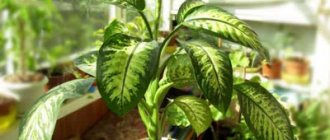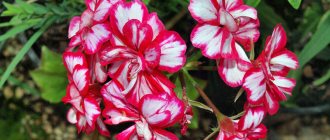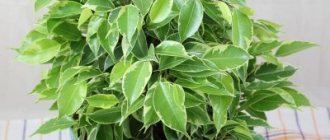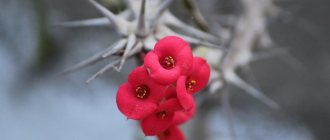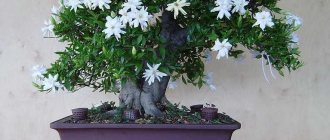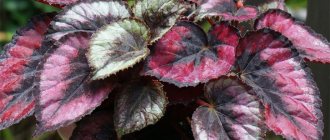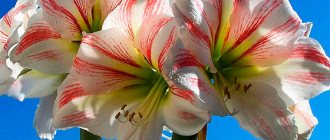Home » In the garden » Greens
Author Nonna Kravtsova Reading time 7 min Published 10/04/2014
When I first saw this plant, I thought it was a type of palm tree. Later I found out that this is a spurge, or rather a certain variety of this species, and I wanted to know what kind of care it needs at home, despite the fact that I didn’t have this plant yet. But I wanted to buy it so badly that I looked for any information about it. And after some time, this amazing flower finally appeared in my house.
Growing milkweed. The illustration for the article is used under the standard license ©delniesoveti.ru
At that time, I worked in a kindergarten and in the dark pool there was a white-veined euphorbia, so weak, since no one really looked after it in this dark place. In general, I decided to steal it, which is what I did. When I took him out of the kindergarten, my hands were shaking violently, since I had never taken anything like that without permission.
In general, there are many types of milkweed, and they are all attractive in their own way. There are euphorbias with and without thorns, and there are varieties with leaves. And all completely different plants have one common property. Each type of milkweed has a white sap inside the stem, similar to milk.
caring for your milkweed at home. The illustration for the article is taken from open sources
But it has nothing in common with milk; on the contrary, milkweed juice is poisonous. According to legends, the ancient Indians made poisoned arrows from milkweed juice. So, if you have small children, then consider purchasing this plant, or put it out of reach of children for a while.
There are types of milkweed that even bloom, but these flowers are not particularly beautiful; on the contrary, they are even inconspicuous.
Euphorbia grows very slowly at home, but if proper care is taken, the flower can grow up to two meters. In addition, milkweed is considered a long-liver.
Why is a transplant needed?
A milkweed transplant is needed in one of these cases.:
- The plant has grown. The roots of the milkweed are already cramped in the old pot, so the flower needs to be replanted.
- The roots of the milkweed have rotted and are affected by a fungal disease. In this case, fresh, uncontaminated soil is like an ambulance.
- The flower arrived from the store in a pot suitable for transportation, but not for living.
- The container from the store is still suitable, but the soil in it is a special substrate with the addition of growth stimulants.
Major diseases
- Excess moisture may cause rot on the roots.
- Leaves may be affected by aphids or mites; the affected areas should be treated with a special pest control solution.
- As for the roots, they can be affected by a root parasite such as mealybug. In such cases, the soil should be replaced and the roots washed.
Ribbed spurge has an exotic appearance and is perfect for any interior in an apartment or house. The flower is not whimsical and will not take up much of your time to care for. Following simple rules will allow you to enjoy the flower for many years.
If you find an error, please select a piece of text and press Ctrl+Enter.
Transplanting at home into another pot
Before transplanting, you need to prepare a container, nutrient mixture and drainage. How to choose a pot:
- Choose a pot taking into account the fact that the roots grow quickly. There should be enough space to install high-quality drainage, 2-3 centimeters wider than its predecessor.
- But the container should not be spacious, because spurge is ready to take up the space around itself. You should not take a growing pot, or a very deep one, also because the water stagnates in such a pot and the roots rot.
When replanting, place a layer of drainage on the bottom of the pot. For good breathability, it is advisable to sprinkle the drainage with rotten tree bark. Pebbles, expanded clay, and crushed tiles serve as drainage.
If a tall plant is being transplanted, heavy stones should be placed at the bottom along with drainage. In this case, the pot will not turn over due to gravity. For milkweed, the soil should be loose, permeable, slightly acidic .
We prepare the soil in one of the following ways:
- We take the following ingredients: peat, turf soil, leaf soil, sand. Mix them in equal parts.
- Mix leaf soil (2 parts), humus (3 parts), sand (2 parts).
- Take a store-bought nutrient substrate for succulents.
If you doubt the quality of the purchased mixture, treat it with water with the addition of potassium permanganate.
The transplant process consists of the following steps:
- Before replanting, water your indoor plant to make it easier to remove.
- Carefully remove the flower from the pot, while using a knife to help separate the edges of the soil from the walls of the pot.
- Inspect the root system, remove damaged or rotten roots.
- Gently shake off excess soil, but do not overdo it so as not to injure the roots.
- Using the transfer method, carefully transfer the plant into a previously prepared pot with drainage placed on the bottom and a thin layer of prepared substrate.
- Sprinkle the spurge with prepared soil.
- Press the surface moderately firmly with your hands.
- Pour warm water with bait.
Propagation of indoor milkweed
New bushes are grown from seeds, cuttings or plots. The easiest way to propagate milkweed at home is vegetative, but it is not always possible. For hemispherical types, only seed is suitable. Some varieties produce shoots from the root.
Cuttings
Vegetative propagation is carried out in the fall. A cutting of at least 10 centimeters in length is separated from the mother specimen. The released juice is carefully removed. You should not leave the lower leaves, as they will take away the strength needed for rooting.
Treat the cut on an adult bush with wood ash. The cuttings are dried, planted in generously moistened sand, and covered with a transparent container. The cut off top of a plastic bottle works great. A prerequisite is maintaining humidity and partial shade.
If they want to get new specimens from leaves, they work with gloves. The edge of the cut is treated with a growth stimulator. The planting is also covered and kept away from the sun, constantly moistening the substrate.
Plant propagation by cuttings
Seeds
To obtain seed, you need a male and a female plant. During the flowering period, pollination is carried out, since dioecious milkweed is not capable of self-pollination. Seeds are collected in the fall.
They are distributed over a moist peat-sand substrate. The sowing is covered with a transparent film or glass. Picking is carried out when the first true leaves appear. Seedlings are planted immediately in pots for adult specimens.
Dividing the bush
In a similar way, you can grow indoor spurge (mile). In early autumn or late spring, the bush is removed from the pot. Inspect the root system. Trim rotten and damaged areas. Divide the roots and stems into plots. The blade is pre-disinfected with alcohol, and the cut areas are sprinkled with charcoal.
The bushes are planted in separate containers. Young plants are placed in the shade until they are completely rooted. In the first year after such a transplant, the spurge will grow rather slowly and bloom very sparingly. This is due to the fact that the flower is exposed to enormous stress.
In open ground
They need to be replanted into open areas in the spring, when the danger of frost has passed.- We need to select the area where we want to transplant the plant. Many garden species grow well outdoors. In the sun or in the shade - depends on the type of milkweed. Heavy and overly moist soil will not suit it.
- Before replanting, loosen the soil.
- If the acidity is high, liming can be done.
- Form a hole in the selected area. Wide enough to accommodate spurge with roots and drainage.
- When planting in open ground, do not forget about drainage.
Fill the hole for planting milkweed with pebbles or expanded clay so that they occupy 1/3 of the space. - Sprinkle compost or rotted bark on top.
- Using the transshipment method, we place a plant with a root clod of soil in the hole.
- Sprinkle with soil with added peat and sand.
- We dig a support nearby to tie up the spurge.
- Mulch with sawdust, humus or peat.
- Further care for the transplanted plant consists of watering and removing dry branches.
When working in the garden with milkweed, it is advisable to wear gloves.
How to deal with common pests and diseases of Euphorbia trigona
Euphorbia triangular is very resistant to various kinds of diseases and pests if you care for it properly. Avoid stagnant moisture in the soil and provide the succulent with the optimal amount of sunlight and good air circulation. This will go a long way in causing problems. Weakened plants can become infected with certain pests and diseases:
- Mealybugs. If you see spider-like threads forming on the plant, wipe them off with a paper towel soaked in rubbing alcohol. If you have a severe infestation, wipe off the mealybugs and spray the plant with an insecticide spray.
- Scale insects. These tiny insects are covered with an almost impenetrable shield. This makes them difficult to remove. If you find any pests, wipe them thoroughly with a paper towel soaked in rubbing alcohol. If that doesn't work, carefully scrape them off with a knife blade. You can also use a neem oil solution or insecticide to remove scale insects and prevent them from returning.
- Cork disease . This is a fungal infection. Patches of dense, corky growths on the stem indicate waterlogging or too rich soil. To save Euphorbia triangularis, trim the plant with a very sharp, sterilized knife or scissors to completely remove damaged areas. Treat the cuttings with a plant fungicide. Replant it in fresh soil mixture and keep it in a constantly warm and spacious place. Reduce watering.
- Rot or fusarium wilt . Another fungal infection transmitted from the soil. If your plant develops soft, reddish spots around the base of the stem, Fusarium head rot is usually the main culprit. In most cases, infection leads to the death of the succulent. The best solution is to get rid of the diseased Milkweed. Be sure to sterilize the pot before using it again.
- Sunburn is a really common problem for Euphorbia. This usually happens when the succulent is indoors and then suddenly exposed to direct sunlight outside. If you are going to take it out onto the balcony or into the garden, first harden it, gradually exposing it to the open sun.
Post-procedure care
Post-procedure care includes:
- After transplanting the spurge into a new pot, it should be watered with settled warm water.
- We take the euphorbia transplanted into a new pot and place it in a lighted place, preferably without hot sun and drafts. The light should be diffused.
- Next, the plant should be sprayed to avoid drying out the soil.
You can read how to care for milkweed in general here.
Types of indoor milkweed
The varieties of the crop are represented by medium and larger specimens. They differ in shape, size, leaves, but invariably attract attention due to their visual attractiveness and unpretentiousness. Even a novice gardener can provide proper care for indoor milkweed at home.
mile
It has a highly branched grayish, tuberous stem with many thick conical needles, whose length reaches 3 centimeters, and the leaves have short petioles. The lower ones gradually die off, and only the apical ones remain. The color of the inflorescences is varied. Bracts with a slight bend.
Euphorbia Mile
Belozhilkovy
It has a thickened and ribbed trunk, dark green leaves with large oval-shaped veins. The inflorescences are quite small and are not highly decorative in themselves, but they look very attractive on the bush. The leaves are renewed only at the top, and at the bottom they simply fall off.
White-leaved spurge
Large-veined
It has dark green leaves with pointed tips and large veins, but in small bushes they are rounded, and the veins gradually darken. With age, the stem begins to become woody and often branches (not always!). If this species is provided with good care, it blooms all year round, covered with small light flowers.
Globular
Ideal for growing at home. It has an unusual appearance. The bush forms spherical small shoots (up to 7 cm), which gather into entire colonies, similar to stones of green and grayish shades.
Globular spurge
Plump, obese
It is small in size and resembles a cactus. The rounded “bush” is devoid of leaves and thorns, but can form “branches” that resemble small balls. The height reaches 15-30, and the diameter is 10 cm. The trunk is octagonal, dome-shaped, over time it becomes cylindrical or cone-shaped.
Read an interesting article - How to grow thyme correctly?
Triangular
This branching succulent reaches a height of two meters. This description, of course, is only true for wild plants. In the room it does not grow to that size. Differs in vertical stems. The top is decorated with thorns, in the axils of which there are ribbed leaves. The plates do not grow more than 5 centimeters.
Triangular spurge
What to do if the plant does not take root?
Having survived the transplantation process, the plant experiences stress and must go through a period of adaptation. But, if the recovery process is delayed, then it is necessary to understand the reason and take measures:
- Perhaps the flower is hot, the clod of earth is too dry. Move it to a cooler place. Spray to increase air and soil humidity. And in the future, regularly water with warm, soft water.
- If there is a suspicion that the spurge is overly moistened, then you need to reduce watering: water only when the soil above is completely dry.
- If in this case there are no changes, then you need to dig up the plant and inspect the roots.
When inspecting the plant before planting, pay attention that if the roots are not watery, have not changed color, and the root system looks healthy, then you can change the soil.Perhaps there is a source of infection in the ground. Before transplanting, the roots should be treated with special means.
We invite you to read other useful articles about milkweed:
- Pruning milkweed.
- Diseases and pests of milkweed.
- Blooming milkweed.
The benefits and harms of the flower
The plant has diaphoretic, anti-inflammatory, analgesic, and diuretic properties. Euphorbia is taken externally and orally. Modern supporters of alternative medicine, aware of the benefits of the culture, use infusions based on it for cystitis, various lesions of the dermis, as well as diseases of the stomach and upper respiratory tract.
Many people are interested in why indoor spurge is dangerous. The leaves and stems of the plant contain a high concentration of a substance that causes poisoning in animals and people. The poisonous juice of the plant provokes a severe allergic reaction on the skin. Symptoms appear within an hour. First, a burning sensation is felt at the site of impact, and then numbness spreads throughout all limbs.
Important! The presence of a toxic substance requires careful attention to therapy. You should not self-medicate without first consulting a doctor or experienced herbalist. In addition, it is necessary to be able to properly prepare drugs, observing all safety precautions.
If a dangerous substance enters the body, it can cause problems with the digestive system. If the juice gets into the mucous membranes of the eyes, vision can be seriously damaged. There are no known deaths due to milkweed poisoning, but it is best to call an ambulance as medical attention will be needed. To prevent this from happening, pruning is done with gloves. It is not recommended to grow milkweed if there is a possibility that pets or children will get to it.
Peculiarities
In winter, it is useful for all types of milkweed to have a dormant period. For flowering varieties this will promote intense flowering in the spring. Decorative deciduous species also need rest in winter.
Lighting in winter, even with artificial lighting, is insufficient for milkweed plants. Therefore, it cannot be kept at room temperature - it stretches out, its shoots become thinner.
During cold wintering, milkweed hardly grows and does not lose its decorative value.
Euphorbia contains caustic, poisonous white juice, which is released abundantly when cut.
If the juice gets into the eyes or just onto the skin, a burning sensation and severe irritation occurs. Therefore, when pruning or replanting a plant, you need to wear protective gloves.
Temperature
The optimal temperature for indoor milkweed is from 19 to 25 degrees Celsius.
In summer, it is possible for the plant to remain on the balcony at temperatures above 15 degrees Celsius, since euphorbia feels good in the open air.
Some types of milkweed can withstand temperatures up to +5 degrees Celsius.
Botanical characteristics
Euphorbia lophogona is an evergreen succulent stem shrub that reaches a height of 1.5 m.
The stem is erect or spirally twisted, narrower at the base, and pentagonal at the top. It is formed by ribs covered with spines arranged vertically.
On the shoots, the remains of the attachment points of the petioles of fallen leaves are clearly visible, and reddish fibers grow on the ridges.
The inflorescences are small, bloom on the tops of pentagons, the color is yellow and green, the bracts are pink or white, the peduncles are up to 5 cm long.
The leaves are petiolate, elongated oval shape, glossy surface, contrasting green color, sometimes with a reddish tint.
The inner side is lighter than the outer side, acts as a reflector of sunlight, the lower tier of foliage falls off as the stems grow, the foliage remains only in the apical part, creating the resemblance of a palm tree. The petioles are thick, the structure is fleshy, the color is reddish.
Varieties:
- White-leaf - distinguished by the presence of a light-colored vein network and less bright, inconspicuous flowering.
- Ribbed (milk euphorbia lactea cristata) is an unusual subspecies that has inflorescences in the form of a bright ridge.
Possible difficulties during cultivation
The main problem for beginning gardeners is the long absence of milkweed flowering. Reasons for a plant’s refusal to form buds:
- lack of lighting;
- lack of nutrition;
- the volume of the flower pot is too large;
- the presence of an excessive number of side shoots that “distract” the flower’s strength from developing.
Correcting the errors returns the bush's ability to bloom and form seeds within two summer months.
In general, caring for comb spurge is simple and does not require time, effort or money. At the same time, the plant pleases the eye with the attractive appearance of lush greenery all year round.
